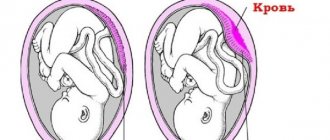What happens to the fetus?
The main achievement of the 15th week is the formation of the fetal cerebral cortex and the active division of nerve cells. At this time, the process of development of the cerebral hemispheres will not end; it will last the entire fourth obstetric month. The smooth surface of the cortex is covered with grooves and convolutions, acquiring a typical structure. The number of neurons corresponds to the approximate norm, the formation of their processes begins. Now the central nervous system is able to perform even more functions and more accurately coordinate the activities of the fetus.
Active development of muscles and bones allows the child to perform a variety of movements. He can roll over, bend and straighten his legs and arms, clench his fists, and suck his fingers. Despite the fact that the epidermis consists of several layers, the skin of the fetus is not yet so dense as to hide the pattern of blood vessels. The hairline becomes thicker, you can see eyebrows and hairs on the head, as well as fluff on the body, which will disappear only a few days after birth. In the thickness of smooth and transparent skin, sebaceous and sweat glands begin their work.
Fetal parameters at 15 weeks:
- Weight – 70 g;
- KTR (coccygeal-parietal size) – 10 cm;
- Body length from heels to crown – 14 cm;
- Heart rate – 120-150 beats/min.
The baby's body proportions change as pregnancy progresses. Now he no longer looks like a clumsy “tadpole” - his body has become more proportional, and his legs, as expected, are longer than his arms. The genital organs are in the developmental stage, so it is still difficult to determine the gender of the child using ultrasound.
Activity of the internal organs of the fetus at week 15:
- The kidneys produce primary urine, which ends up in the amniotic fluid;
- The intestines develop;
- The liver produces bile, which will become the basis for the original feces - meconium;
- The endocrine glands of the male fetus begin to produce testosterone;
- The head cords are formed, the glottis is open;
- Receptors on the tongue and oral cavity are able to recognize the taste of food;
- The heart pumps more than 28 liters of blood per day.
Amniotic fluid is cleaned up to 10 times a day, so the child does not experience discomfort. Due to the intense work of the cardiovascular system, the skin of the fetus most often has an intense pink or red color.
Video about the prevention of stretch marks and the condition of the fetus at 15 weeks:
Mom's belly
The uterus rises more and more from the pelvic cavity - the expectant mother’s belly continues to grow. However, it happens that it becomes noticeable only now. This is absolutely normal! If a woman is pregnant for the first time, her belly, as a rule, begins to round later and at 15 weeks differs from the belly of a pregnant woman who already has children.
What should alert the expectant mother is pain in the lower abdomen during pregnancy - now they can be a sign of increased uterine tone, and in some cases, placental abruption. Be sure to consult your doctor. But don't panic ahead of time! Often, pain occurs due to problems with the intestines or sprains of the ligaments and muscles that support the growing uterus.
How do the belly and uterus grow?
At week 15, the fetus can be compared in size to an orange. The pregnant uterus has already moved beyond the small sac, rising higher into the abdominal cavity. The fundus of the uterus is located at a level of 7-10 cm below the navel, or in the middle of the distance between the navel and the pubis. These parameters are measured by the midwife at each visit to the antenatal clinic, and the result is entered into the pregnant woman’s exchange card.
When performing an ultrasound at this time, it is clear that the myometrium (muscular layer of the uterus) has a uniform structure and a thickness of 2.5 cm. The uterus has increased in size so much that it can be felt in a lying position through the peritoneal wall.
The belly at this stage of pregnancy increases at different rates. For example, in thin pregnant women with developed abdominal muscles, the stomach may not be visible outwardly. And for some, a rounded tummy and smoothed waist lines are already visible to the naked eye at 15 weeks.
A vertical dark stripe in the middle of the abdomen is a manifestation of increased melanin production, which is caused by increased work of the endocrine glands. This defect will disappear soon after birth.
Body changes and new sensations for women
Many women have a changing figure, new movements appear: in addition to a “blurred” waist and an already noticeable belly, in pregnant women the lumbar deflection of the spine increases, the gait transforms (popularly it is also called “duck”) - the expectant mother seems to waddle from one foot to another ( this is due to weight gain and a shift in the center of gravity at week 15).
The volume of blood in the female body also increases, which is necessary to improve the functioning of the placenta. As a result, excess blood flow appears in small blood vessels, so expectant mothers may experience light nosebleeds and bleeding from the gums during this period (especially while brushing their teeth).
Second trimester screening and ultrasound
The 15th week is the period from which a pregnant woman, for special indications, receives a referral for a second screening study for pathologies of fetal development. According to the plan, the second screening is carried out from 16 to 20 weeks.
It includes an ultrasound examination and a “triple test”:
- Blood test for hCG content;
- Analysis for alpha-fetoprotein content;
- Analysis for unbound estriol content.
If for some reason a woman was unable to pass the first screening tests, then the indicators obtained as a result of a more informative triple test will be sufficient. Do not panic in advance if you get not very good results - they need additional confirmation. A titer of 1:350 is considered the basis for an in-depth study - puncture of amniotic fluid. A woman has the right to refuse to have her amniotic fluid taken for analysis, although this analysis identifies possible genetic and chromosomal pathologies of the fetus with 100% accuracy.
An ultrasound performed on high-precision equipment with high resolution can lift the veil of secrecy about the gender of the unborn child, although there is a high probability of error here. But the active movements of the fetus and even its facial features can be clearly distinguished on the screen.
Tests and ultrasound
If the first planned ultrasound during pregnancy at 10–14 weeks showed that the fetus is developing somehow incorrectly, at 15 weeks (or a little later) the doctor may suggest that the woman do a second ultrasound and also undergo a “triple test” (recently experts are increasingly considering it mandatory for all pregnant women), which includes the determination of the following biochemical markers: AFP - blood plasma protein, hCG - human chorionic gonadotropin and E3 - female sex hormone (estriol). This blood test (it is taken from a vein from a pregnant woman) is absolutely safe for the health of the expectant mother and fetus, but its results are not diagnostic - they only help assess the risk of giving birth to a child with Down or Edwards syndrome and a neural tube defect.
Feel
If a woman monitors her health and regularly visits the doctor, nothing unusual should happen during this period. Perhaps her nose is periodically stuffy and the volume of nasal mucus secreted increases. These are signs of pregnant rhinitis - a runny nose caused by hormonal changes.
During the period of active construction of the fetal skeleton, a lack of calcium in the mother’s body may occur. Nails and hair become fragile, brittle, from time to time the woman feels cramps in her limbs, and tooth enamel crumbles. Such symptoms of calcium deficiency are possible with a poor, monotonous diet of the expectant mother. You should more often include cottage cheese, cheese, fermented baked milk, kefir, and sour cream in your diet.
The symptoms of toxicosis are almost not felt; a feeling of constant fatigue and absent-mindedness may remain. A woman at 15 weeks of pregnancy notices that her nipple areolas and the skin of her external genitalia have darkened, and pigment spots have appeared on her body and face. All these manifestations will go away in the first months after birth.
At 15 weeks, changes in blood pressure may begin, causing nosebleeds and bleeding gums. From this date, you need to start carefully monitoring your blood pressure and regularly measure it when visiting a doctor.
Feelings of a expectant mother at 15 weeks of pregnancy
Usually during this period it becomes easier for pregnant women. Normally, there should be no manifestations of toxicosis. Some may still experience morning sickness. If vomiting does not stop, you should consult your doctor about changing your diet. In the absence of signs of toxicosis, the expectant mother develops an appetite. At the same time, you should control your weight and not overindulge in food, since extra pounds can harm your baby.
Breasts continue to fill at 15 weeks of pregnancy. Freckles, moles and nipples become darker due to the synthesis of melanin. This is a temporary phenomenon that goes away after labor.
For the full development of the fetus, micronutrients and vitamins are needed. If a woman does not get enough of them from her daily diet, she may experience leg cramps. Convulsive conditions appear against the background of a lack of potassium, magnesium, calcium and a decrease in glucose levels.
Despite the subsidence of signs of toxicosis and general improvement in condition, a pregnant woman may experience other unpleasant sensations at this stage: difficulty breathing, nasal congestion, increased or decreased blood pressure. If a expectant mother has headaches, cough, itchy nose and runny nose, this is not always a sign of a cold. These symptoms are explained by hormonal changes. Excessive estrogen production causes swelling of the mucous membranes and an increase in mucus in the nasal cavity. This condition is not dangerous to the fetus, but causes significant discomfort to the woman. Her irritability increases, sleep is disturbed, and fatigue appears.
Low blood pressure in a pregnant woman can cause drowsiness, general malaise and weakness. With increased blood pressure, the risk of headaches, development of gestosis and swelling increases. Fluctuations in blood pressure in expectant mothers can be triggered by insufficient physical activity, excess body weight, frequent stress, mental or visual strain and other factors.
Baby's first movement time
During the first pregnancy at 15 weeks, fetal movements are imperceptible. Being completely at rest, they can be noticed by women of fragile build who are pregnant with their second and subsequent children. The movements are so gentle that the doctor usually attributes the woman's report of new sensations to a sensory error caused by intestinal motility. However, a woman’s instinct is unlikely to confuse these movements, similar to the “touch of a butterfly’s wings,” with anything. Women who have no experience of pregnancy also feel them, but perhaps do not understand it yet.
Changes in the body of a pregnant woman at 15 weeks
The development of pregnancy at week 15 introduces some unfavorable changes in the body of the expectant mother. During this period, pregnant women notice a deterioration in the condition of the skin, hair and nails, as well as crumbling teeth. This happens for the reason that all energy costs and nutrients from the mother’s body go to the development of the fetus. In the second trimester of pregnancy, the fetus continues to actively develop and grow; it requires large quantities of nutrients, vitamins and microelements, especially calcium and proteins.
Vaginal discharge at 15 weeks
Normal discharge at this stage is transparent, quite dense, sometimes with a milky white tint. Due to the predominance of estrogen, they may become somewhat thinner than they were at the beginning of pregnancy, but the color and smell of vaginal discharge from a healthy woman remains unchanged.
The appearance of a yellow or green tint, the inclusion of cheesy clots, pus or mucus, and the addition of an unpleasant odor are signs of an infectious lesion of the reproductive organs. This condition is extremely dangerous for the pregnant woman and the fetus, since some pathogenic microbes can penetrate the placental barrier. A change in the nature of the discharge is a reason to consult a doctor and begin treatment.
General recommendations for the expectant mother at 15 weeks
“Keep a sleep and rest schedule, go to bed on time, don’t overload yourself, try to wear clothes made from more comfortable and natural materials, and, of course, stick to a healthy, balanced diet,” advises Maria Prokhorova. - If you continue to play sports during this period, it should still be moderate exercise. In an effort to maintain an attractive figure and muscle corset, please do not overdo it in the gym. Have an easy and comfortable pregnancy!”
Pain - signs of pathology
Every pain sensation requires careful diagnosis. Sometimes the pain is caused by functional changes in the body (stretched ligaments of the growing uterus, leg cramps due to lack of calcium). However, severe spasmodic pain in the lower abdomen and lower back, accompanied by bleeding, can be caused by a miscarriage. Placental abruption, rejection of the fertilized egg, causes bleeding and painful spasms of the uterus, radiating to the lower back.
If the fetus has no pathologies, and the miscarriage is diagnosed at the very beginning, you can try to save the pregnancy. To do this, you need to seek emergency medical help at the first symptoms.
Pain when urinating may be a sign of cystitis. Inflammation of the bladder often occurs during pregnancy due to decreased immunity, side effects of thrush, and as a result of hypothermia. Cystitis needs to be treated quickly and effectively in order to prevent its complication - pyelonephritis, which will take much longer to fight.
What happens to a woman’s body at 15 weeks of pregnancy?
As we have already noted, 15 weeks is the easiest, so-called “golden” period of pregnancy. The expectant mother continues to fine-tune herself to successfully carrying a baby, but over the previous weeks she has already become accustomed to her magical state, and her belly is not yet so large as to cause her discomfort. Our expert spoke about the main changes occurring in the body and the sensations of a woman in the 15th week of pregnancy.
• A small belly is already visible in thin expectant mothers, while in the appearance of more well-fed women, nothing usually appears that could help others visually “diagnose” her magical state. • Weight gain during this period is individual for everyone, but in general, with rare exceptions, it is no more than 2-3 kilograms. • As the unborn baby grows, the load on the woman’s pelvic veins and venous system gradually increases, so during this period you should change your body position and move as often as possible, especially if the future mother’s work does not involve sufficient physical activity. • During the 15th week, some expectant mothers may experience pain in the lower abdomen and lower back.
“Don’t be alarmed: as a rule, this is due to the growing uterus,” says Maria Prokhorova. - The main thing is that these pains are not sharp, cutting, acute and prolonged and are not permanent. But in any case, if the expectant mother is bothered by certain painful sensations, she should consult a doctor to adopt the correct pregnancy management tactics.”
• As throughout the entire period of bearing a child, odorless mucous discharge and droplets of blood are considered normal at the 15th week. • Fetal movements at 15 weeks are not yet felt by the expectant mother, although the baby is already moving quite actively. • If you lightly press on the nipples of a pregnant woman, you can find light droplets of colostrum on them: this is how the smart and prudent female body gradually prepares for subsequent breastfeeding. • Sometimes pregnant women experience drowsiness, but this condition can be easily corrected if you follow the correct work and rest schedule and go to bed on time. In any case, the expert recommends that the expectant mother get more rest, starting from the 15th week of pregnancy.
pixabay.com/alessandraamendess
Vaginal bleeding
An admixture of blood in vaginal discharge, brown spotting or leucorrhoea, the appearance of bright red blood with clots - all this requires immediate consultation with an obstetrician-gynecologist.
Possible causes of bleeding:
- Spontaneous termination of pregnancy;
- Cervical erosion;
- Frozen pregnancy;
- Trauma to vaginal tissue or external genitalia;
- Malignant lesion of the reproductive organs.
Pregnancy with twins
At this stage, a multiple pregnancy hardly deviates from the normal course. Perhaps the early toxicosis has lingered somewhat, but it will soon pass. If a woman registers with the antenatal clinic in a timely manner, it means that a planned ultrasound has already been performed, and she knows about a multiple pregnancy. It is important to pay close attention to your health, eat right and spend more time outdoors to replenish your body's resources in a timely manner.
What does elevated body temperature mean?
At this stage of pregnancy, we can no longer talk about low-grade fever in the first weeks caused by hormonal changes in the body.
Now hyperthermia is a dangerous symptom of an inflammatory or infectious disease:
- Cystitis;
- Pyelonephritis;
- Flu;
- Measles;
- Rubella;
- Mumps;
- Chicken pox;
- Sexual infection.
Since high temperature is dangerous for the fetus, just like viruses, immediate treatment should be started and the thermometer should be lowered. At week 15, in consultation with your doctor, you can already take antipyretic drugs with minimal side effects. One of these drugs is paracetamol, or medications in which it is the main active ingredient.
What does the belly look like at 15 weeks of pregnancy?
Attention!
This article is posted for informational purposes only and under no circumstances constitutes scientific material or medical advice and should not serve as a substitute for an in-person consultation with a professional physician.
For diagnostics, diagnosis and treatment, contact qualified doctors! Number of reads: 4008 Date of publication: November 28, 2017
Gynecologists - search service and appointment with gynecologists in Moscow
Viral and colds
Influenza, acute respiratory infections, ARVI are diseases that, unfortunately, a pregnant woman can easily get sick with. Viruses that provoke the development of these pathologies can be dangerous for the fetus and infect it even through the placental barrier. Treatment of influenza and acute respiratory diseases with high fever is best done in a hospital setting. If therapy is carried out at home, it takes place under bed rest.
Activities and procedures:
- Drink plenty of fluids;
- Taking vitamins;
- Gargling with soda solution, chamomile or sage decoctions;
- Rubbing the chest when coughing;
- Inhalations with medicinal herbs;
- Rinsing the nose with sea water;
- Using tea tree oil to lubricate a sore throat.
Alcohol and nicotine
Toxins entering the mother’s body after smoking a cigarette or drinking a glass almost immediately penetrate the fetus’s body through the circulatory system. At this stage of pregnancy, the cerebral cortex is actively developing, so the effects of alcohol and nicotine can negatively affect the development of the child’s intelligence and its higher mental functions.
If a pregnant woman has an irresistible urge to drink beer or wine, it may be the result of a lack of protein. The deficiency can be compensated by eating nuts or preparing a dish of lean meat.
Diagnostic procedures
The 15th week of pregnancy is the period when you do not need to undergo any mandatory tests. If the process of bearing a baby is normal, you can take a little break from visiting the doctor. If the need arises, you will have to undergo an examination by a gynecologist and take a general urine test.
If indicated, your doctor may recommend:
- Ultrasound to clarify the size of the child and identify developmental defects.
- Taking a test to determine the level of hCG in the mother’s blood. When its values are lower than normal, pathology of the placenta may be observed.
- If there is a high risk of developing genetic abnormalities, amniocentesis may be required.
During a gynecological examination, the condition of the cervix is assessed for timely diagnosis of isthmic-cervical insufficiency. By palpation you can determine the location of the uterine fundus. Its height is 14-16 centimeters.
The 15th week of pregnancy does not require a mandatory ultrasound. It can only be used if there is a suspicion of pregnancy pathology or fetal development abnormalities.
Balanced diet
To replenish the reserves of protein needed by the fruit, you should eat at least 200 g of meat daily. This volume is replaced with fish twice a week. In addition to meat and fish, a pregnant woman’s diet includes porridge with milk, cheese, eggs, cottage cheese, fermented milk products, vegetables and fruits. To strengthen the placenta and the walls of the uterus, a lot of vitamin E is required. Most of it is in vegetable oils, nuts and seeds.
It is advisable to consume only high-quality and safe products that have passed sanitary control. If there is a suspicion that meat or fish contains antibiotics or growth hormones, it is better to avoid them.










